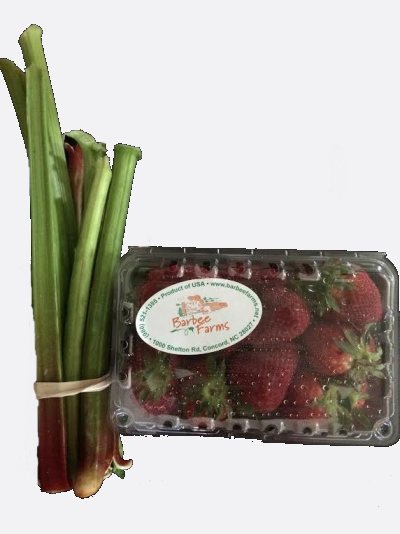By Jean Blish Siers *
 I bought rhubarb at Barbee Farms this week. That simple sentence doesn’t really tell you how important that was to me! As a child growing up in Minnesota, I took rhubarb for granted. My father had veritable hedges of rhubarb scattered around the farm and it was one of the first signs of spring, a dependable fresh fruit that we all loved. My mother made cakes and pies and jams and sauce out of it.
I bought rhubarb at Barbee Farms this week. That simple sentence doesn’t really tell you how important that was to me! As a child growing up in Minnesota, I took rhubarb for granted. My father had veritable hedges of rhubarb scattered around the farm and it was one of the first signs of spring, a dependable fresh fruit that we all loved. My mother made cakes and pies and jams and sauce out of it.
When we moved to Charlotte, North Carolina thirty years ago, my father sent a big rhubarb root along with us. We dutifully planted it and it came up in the spring, sending tiny shoots through the red clay. And then it died. We tried again. And it died. We learned that rhubarb doesn’t like the comparatively warm winters in Charlotte. It needs a good cold snap to make it grow.
Barbee Farms, where we glean often during the harvest season, is among several local farms involved in an agricultural trial, raising rhubarb in the South as an annual. This is their first year, and it’s delicious! I bought a bunch, along with some of their beautiful strawberries, and brought them home yesterday. Cutting up the rhubarb to make my mother’s Rhubarb Crunch recipe, I felt like a little girl again. My jaws cracked just smelling the tart stalks!

The famous French chef Jean Anthelme Brillat-Savarin said, “Tell me what you eat and I will tell you who you are.” Food is such a vital connection to our homes, our childhoods, our families. I think of that in the summer when we deliver a fresh tomato, warm from the field, to a senior citizen. Listen to someone talk about making a tomato sandwich on a July day, and you know you’re bringing them more than food. Or see the joy on a face when they get a watermelon picked that day, or a bag of corn with the silk still soft.
We take food regularly to a refugee community. Last year, Tega Hills Farm allowed us to glean a wild and exciting variety of hot peppers from their greenhouses. What a treat for the refugees who received them – again, a taste from home.
Psychologists and neuroscientists explain that food memories are so powerful because food triggers all our senses, not simply taste and smell. And those senses trigger memories of the experiences associated with that food. That rhubarb isn’t just a good fruit to me; it takes me immediately to memories of my parents, the warming soil of a Minnesota farm, our family gathered around the big dining room table for dessert. A tomato takes a senior back to younger days, which is so important. And perhaps more importantly, we can help a child begin to build her own happy food memories. How wonderful for a child to remember eating watermelon with her parents or grandparents, rather than junk food from the local convenience store!
I’m looking forward to another season of bringing good food and good memories to people all across our region. But first I might have to buy just a little bit more rhubarb!
To get you started this spring, here is my mother’s Rhubarb Crunch recipe. Feel free to add strawberries. Enjoy!
Rhubarb Crunch
Ingredients:
Filling:
- 4 cups fresh rhubarb (cut into 1/2-inch pieces)
- 1 cup Sugar (or less, to taste)
- 2 tablespoons flour
- 2 tablespoons butter
Topping:
- 1 cup sugar
- 1 cup flour
- 1 tsp. baking powder
- 1 egg, beaten
Directions:
- For filling, mix rhubarb pieces with flour and sugar in a bowl. Pour into buttered 8-inch or 9-inch square pan, and dot with butter.
- Sift together remaining one cup sugar, flour, and baking powder, and stir in the egg. Mixture will be gooey and crumbly. Sprinkle over the rhubarb mixture and shake the pan a little.
- Bake at 350 degrees for about 40 minutes until bubbly and browned. Freezes well.
* Jean Blish Siers is SoSA’s Charlotte Area Gleaning Coordinator
APR
2018

